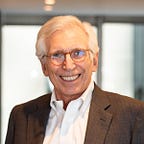Pete Sanford’s Magnificent Bar Mitzvah: A Family Occasion in the Pandemic Era
Peter Mark Sanford was still twelve when he told his mother Katherine, my daughter, that he wanted to study for a Bar Mitzvah. Being one-quarter Jewish and living in a secular home in Woodacre, California, Pete’s determination surprised his mother because, as the saying goes, it seemed so random.
His encounters with organized religion were virtually nil. His experience with Judaism, I would joke, was having seen “Fiddler on the Roof” on Broadway, playing Tevye in a family summer take-off and Seders with local family and friends.
So a Bar Mitzvah? Why? How?
Preparation would be from a standing start. Katherine, with her husband Colin’s support, said she would locate an appropriate instructor in Torah somewhere nearby on the condition that if Pete embarked, he had to commit to finishing, absolutely.
When I was told that Pete wanted me to be his partner in exploration of the Torah, I was daunted. I am one hundred percent Jewish and my parents’ lives in Europe and later the United States were shaped by their Jewish identity. But in the U.S., aside from Passover, there were no regular Jewish observances, no synagogues, no High Holy days, not even Hannukah.
As a callow youth on the Upper West Side of Manhattan, I asked for a Bar Mitzvah and got one. We had a party in the apartment rather than the typical fête in a rented venue. All I remember of the Torah study was that my portion was about the circumcision of Abraham.
It was me wanting what other kids had but I have always thought I didn’t earn it.
Pete, on the other hand, in his remarks at our ceremony in his backyard on October 25th, explained his decision this way:
“I didn’t do it because I think there is a God or because I’m religious, because both of those things are not true about me. I did it to have a different experience than the thousands of kids I knew who were on quite linear paths. I learned a new culture, a new language and new traditions that gave me a perspective other kids didn’t have…”
Pete’s Torah instructors, Mia Zimman and Fredi Bloom, met with him regularly in person and later on Zoom for Hebrew lessons, teaching him the prayers and the protocols. My role was to explain the Torah, generally, and eventually to discuss his portion to be chanted. We did this by phone on Saturday mornings — informed largely (and confidentially) on my end by Torah For Dummies. Gradually, our shared impressions of the sacred texts took hold.
“When you begin to break down stories to find the moral payouts,” Pete said in his remarks, “you also notice flaws. The story of Adam and Eve stands out to me. Eve is portrayed as the antagonist versus Adam who is just the innocent, unfortunate bystander…”
The Torah, Pete concluded, was out of sync with much of today’s thinking, “some of its biggest pillars were built on ideas that are not fair…” Together we understood that the lessons in these five books of the Old Testament were spiritual objectives and not necessarily examples to follow.
***************************************************************
The Bar Mitzvah was originally scheduled for last June at a nearby community center with an arc where the Torah scrolls were kept. The pandemic forced a postponement until October 25th, outside on a sunny fall afternoon.
Those on hand were Pete’s parents, his brother and sister, his cousin Eli White, a skeptical Catholic who flew out from New York as did my wife, Susan, his grandmother, and me, with Mia and Fredi leading the ceremony and singing in lovely harmony.
Everyone had a role to play with prayers and responses, comments for Pete from his parents and grandparents. Pete’s autistic sister Mae gave him a high-five.
Ben, Pete’s sixteen-year-old brother, and Pete were draped in Tallit shawls. Lunch was bagels and trimmings along with a fresh challah, the bread that is customary at the Sabbath and on holidays. The boys were also well attired in new blazers, white shirts, ties and slacks. Pete wore his bright white Nikes, a declaration of personal choice.
It was a simple, beautiful ceremony, digitally recorded to be shared with all those who might otherwise have been in attendance. The Torah was carefully placed on a tablecloth, signed over generations by his relatives and normally only used for Christmas week family meals.
In all, this occasion paid tribute to the occasion itself and the extraordinary circumstances of this year’s season of holidays and rituals. It was not what it might have otherwise been. And yet, it seemed just right for Pete, his family and his teachers.
I don’t know what the experience will mean for Peter Mark Sanford over the long term. This was, however, a passage that showed Pete’s developing character, his strong sense of community combined with an instinct to go his own way. It was also a much-appreciated tribute to his Jewish ancestors, whose names we know all the way back to 1740.
